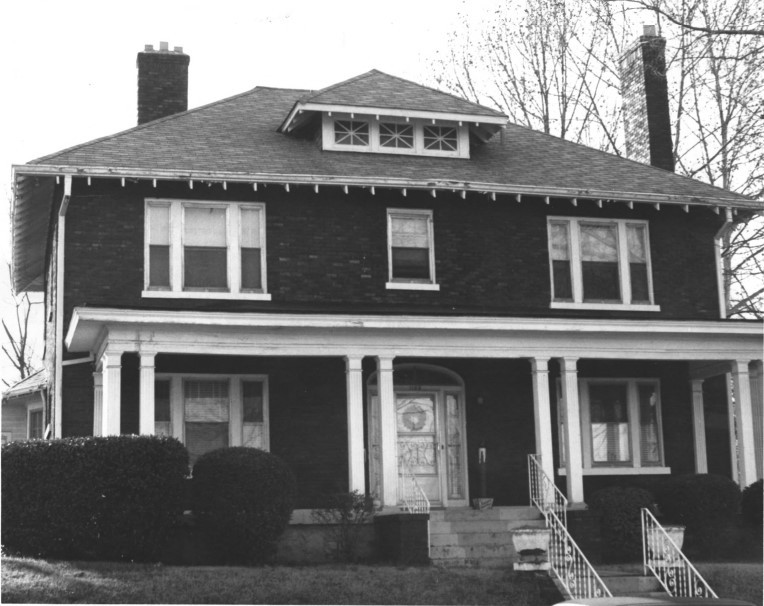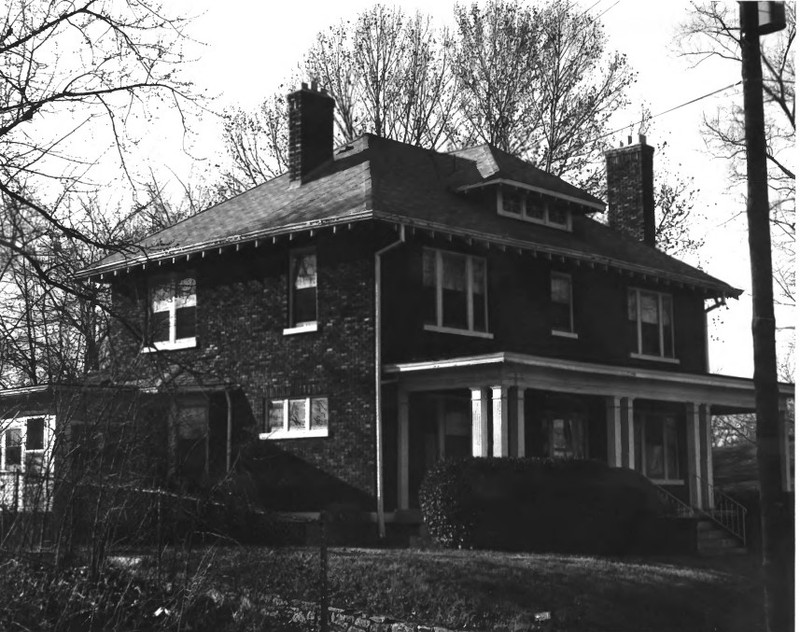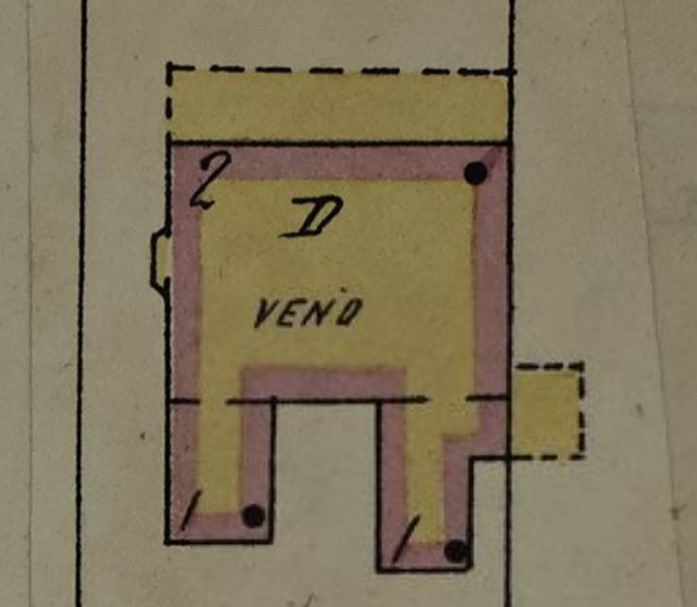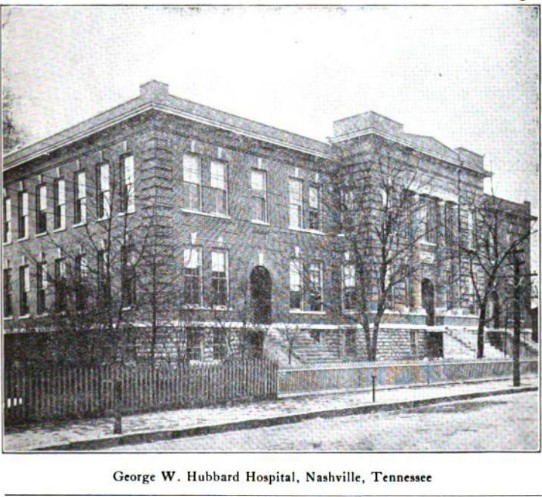Hubbard House on Meharry Medical College old campus
Introduction
Text-to-speech Audio
The red brick house at 1109 First Ave. S. was constructed for the retiring president of Meharry Medical College, Dr. George W. Hubbard, in 1921. The home was on the college's campus, a medical school for African Americans, in the 1920s. No other school buildings from the campus have survived urban renewal. When the medical school was established in 1876, it was the first school in the South founded to prepare African-American physicians. The house was designed by prominent African-American architect Moses McKissack. The house became a parsonage for a local church in 1970 but is currently vacant. In 1973, the Hubbard House became a listing in the National Register of Historic Places. Efforts are underway to renovate the building.
Images
Front of Hubbard House in 1973 photo for NRHP (May Dean Eberling)

Front and south side of Hubbard House in 1973 (Eberling)

Close-up of wood-framed Hubbard House with a brick veneer, on a circa 1950 Sanborn map (Vol. 2 p. 200)

ca. 1912 photo of former George W. Hubbard Hospital nearby at 1115 First Ave. S.

Backstory and Context
Text-to-speech Audio
The Neo-Classic style Hubbard House was designed by McKissick and McKissick, one of the leading architectural firms in the country with African-American principal partners. Trustees and alumni of Meharry Medical College paid the circa $17,000 cost of building the home for the school's retiring president. Dr. George Whipple Hubbard (1841-1924), a White physician from New Hampshire, was appointed in 1876 by the U.S. Freedman's Aid Society to organize a medical department at Central Tennessee College. The school's first graduate was James Monroe Jamison, in 1877. The school's first new building, a four-story brick structure, was near First Street S. and Chestnut Ave.; students began using "Tennessee Hall" around 1880. A member of the class of 1882, Robert F. Boyd, was the first African-American physician to establish a private practice in Nashville. A dental and pharmaceutical hall was built on campus in 1889.
Central Tennessee C. was founded in 1865 by missionaries on behalf of the northern Methodist Episcopal Church for the education of freedmen; it became Walden University in 1900 to honor Bishop John Morgan Walden. Walden U. became a junior college in 1922 and closed in 1925 for financial and social reasons - there was competition from state-sponsored colleges; amid racial strife, many African-Americans migrated north.
Meharry Medical College was named for a family that helped found the medical college, five Scotch-Irish brothers. In 1900, it became Meharry Medical College of Walden University. A hospital was built in 1910 on First Ave. S. (#1115, down the street from the future location of the Hubbard House at #1109) and was named George W. Hubbard Hospital. A wing was added to the hospital in 1912; it then held 55 patient rooms. The $40,000 structure is no longer standing and has been replaced by single-family homes. Education in nursing was added to the offerings of Meharry by the 1910s. Meharry received its own state charter in 1915; by 1918, it was educating over 500 medical students. Dr. Hubbard served as president of Meharry from 1915 to his retirement in 1921. His wife, Sarah, died in 1921 at age 95. He passed away three years later, in 1924, at age 83. The couple are buried in Nashville's Greenwood Cemetery.
In the early 1930s, Meharry moved to a larger space in northwest Nashville where a modern school and hospital were built. Meharry Medical School and Meharry Hospital continue to provide health care and education on the new campus; they are affiliated with the United Methodist Church. In 1970, the Hubbard House became owned by the Seay-Hubbard United Methodist Church, which occupies a brick building down the street from the house. The church used the Hubbard House as their parsonage.
The Hubbard House is actually wood frame with a brick veneer; it features an extended front porch and a hipped roof. The house contained ten large rooms plus a basement. Not much had changed in the house design by the early 1970s when it was added to the National Register, except for enclosure of a side porch. A nonprofit organization, Hubbard House Nashville, has been set up to restore the six-bedroom, two-bath house. The Friends of Hubbard House Inc. are currently gathering donations toward renovation of the house.
Sources
Anonymous. George W. Hubbard Hospital. Journal of the National Medical Association, vol. 5, no. 285 - 86. Published January 1st, 1913. Google Books.
BruceLT. Find A Grave Memorial for Dr. George Whipple Hubbard, Find A Grave. August 8th, 2013. Accessed September 2nd, 2022. https://www.findagrave.com/memorial/115139082/george-whipple-hubbard.
Eberling, May Dean. NRHP Nomination of Hubbard House, Nashville, Tennessee. National Register. Washington, DC. National Park Service, 1973.
Historic Nashville Inc. Hubbard House, Historic Nashville Inc. October 18th, 2016. Accessed September 2nd, 2022. http://www.historicnashvilleinc.org/nashville-9/hubbard-house/.
Linda. Find A Grave Memorial for Sarah A. Hubbard, Find A Grave. November 9th, 2013. Accessed September 2nd, 2022. https://www.findagrave.com/memorial/120056862/sarah-a-hubbard.
Lovett Bobby L. Walden University (1868-1925), Tennessee State Library. Accessed September 2nd, 2022. https://web.archive.org/web/20080724102626/http://www.tnstate.edu/library/digital/walden.htm.
Meharry Medical College. About Us, Meharry Medical College. January 1st, 2022. Accessed September 2nd, 2022. https://home.mmc.edu/about/.
Parham, Sandra Martin. Meharry Medical College. Campus History. Charleston, SC. Arcadia Publishing, 2021.
https://npgallery.nps.gov/AssetDetail/NRIS/73001760
https://npgallery.nps.gov/AssetDetail/NRIS/73001760
Library of Congress (LOC): https://www.loc.gov/item/sanborn08356_012/
Journal of the National Medical Association 1913 (Vol. 5 No. 2 p. 85); Google Books
